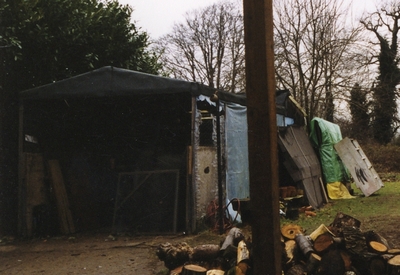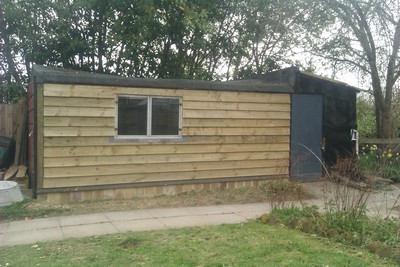When I moved into my cottage there was a garage / carport / workshop in the backyard. The roof, a heavy boarded felt roof, was held up with 2 x 2 uprights. For those of you not English, or too young to know inches, that’s 50 x 50 mm lengths of wood, incredible flimsy for the job. The whole thing was leaning so I anchored it to the Laurel hedge, winched it upright and braced it up. Years later in 2015 it was time to replace the uprights and build a decent side to my workshop. I laid a footing and a row of blocks, inserted much stronger wooden posts, built in a window and then came the job of cladding. I used 16 foot lengths of 8 inch feather edge, not too heavy until you have to hold them up with one hand to get the first nail in. The following morning my left shoulder was in agony.
When I broke my back I also broke my collar bone to which the consultant’s answer was that collar bones mend themselves. The two halves were so overlapped that it was only possible for them to join fibrously and the more active I became the more the two halves moved. Two and a half years after breaking my back I finally persuaded a surgeon to bolt the two halves back together, but the damage was done. Having to use a wheelchair with catastrophic collapse of the core structure of your body is bad enough. Top that with a broken collar bone and you end up with serious weakness and deformation of structure. Amazingly, for nearly 20 years my left shoulder rarely troubled me, until I built my workshop wall.
The body has an incredible capacity to compensate and had locked in the weakness using the outer muscular shell to provide the necessary stability for the use of the arms. The shoulder blades, that should play a substantial part in stabilising the arms, were sunk into the body and floated around playing no functional role and yet I could use my arms for strenuous activity, albeit not in a good way. As we slowly but surely improved the structure of my trunk we opened up the collapsed structure and exposed the weaknesses that had been buried for so long. The alignment of the structure was improved but the connections so weak that all of a sudden I had to be so careful as to how I used my upper body. Nailing up the cladding to the workshop wall was too much for the newly exposed weaknesses.
Since then my shoulder has gone through so many stages. We have worked deeper into the body exposing and strengthening level after level, little by little getting to the core of the problem. Strangely, the more we rebuild the structure the more strength I find to lift my weight and move my body around while at the same time small movements can become difficult. At one point I struggled to lift a dinner fork to my mouth. The shoulder blade is so much better anchored these days and we are now exposing weakness in the connection of the humerus, at the ball and socket, and the upper arm. Although stronger than ever sometimes when sitting still my arm will lock at the shoulder joint and I physically have to lift it with the other hand to free it off. The paradox of improving strength on one hand and difficulty with gentle movement on the other is fascinating, but the great thing is I continue to improve and one day my left shoulder will cease to trouble me.







